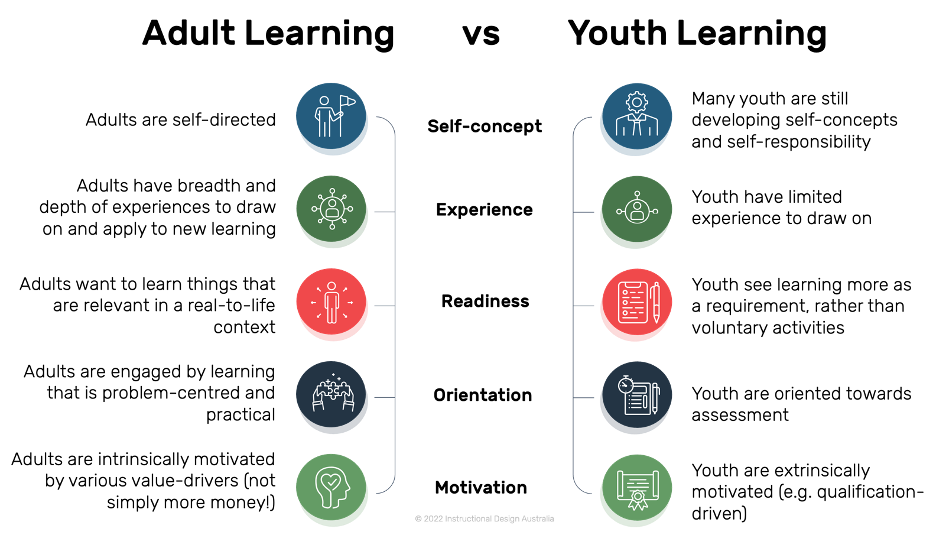Designing Learning for Youth Audiences
Youth – they’re not quite adults, but they’re not young children either! How do we bridge the gap between child and adult learning to design experiences for youths that are engaging and relevant to their lives?
Differences between adult and youth learning
Both pedagogy and andragogy are models used to plan, design and deliver learning. Pedagogy has an emphasis on education for children, whilst andragogy is most effective for adult learning. This is because historically, pedagogy is teacher-led and subject-centred, whereas andragogy is self-directed and problem-centred[1].
Since youth is a transition between childhood and adulthood, so is their learning – from pedagogical to andragogical learning contexts. Young people are not fully self-directed; however, they seek to be guided, rather than handheld. They’re action-orientated and want to learn through social interactions and situations that reflect the real world. They’re still learning to take responsibility for their own learning and need support in doing so.
Growing up in the digital age
Growing up in a digital world looks much different than adolescence 20 years ago. In the age of laptops and tablets, smartphones and smartwatches, video games, VR, and an app for every need, young people are continuously online. They use technology to connect with others, express themselves, and learn new skills. With a third of internet users under the age of 18, digital technology is a staple in their day-to-day lives[2].
So – how does this relate to learning?
It shows that they’re:
- Social (online): They post comments, create chat rooms, video call and share links
- Creative: They like to share their ideas through videos, photos, text, podcasts, songs and other modes
- Resourceful: They can find the information they need, when they need it, using a variety of tools, software and apps
Designing learning for youth audiences
Ok – but what does effective learning design look like for youth audiences?
Here are some tips that draw on research for engaging youth learners:
- Explain the relevance of learning upfront, including the vocational outcomes and assessment requirements.
- Focus on pedagogy (child-learning practices), whilst slowly introducing andragogy (adult-learning practices).
- Use both intrinsic and extrinsic rewards to motivate youth.
- Provide some opportunities for self-directed learning, whilst supporting learners and providing regular feedback.
- Slowly increase young people’s responsibility for their own learning.
- Incorporate digital technologies to allow them to find information, communicate and demonstrate their learning in creative ways[3][4].
Whilst the learning principles may vary between youths and adults, engagement strategies – such as application-based, contextualised, real-to-life learning – remain the same for both audiences. Both adult and young learners should be:
- Actively participating in their own learning
- Challenged
- Purpose-driven (aware of the ‘why’ and ‘what’s in it for me?’)
- Aware of their own progress and growth
The GEARS framework for youth learning
The GEARS model acknowledges the transitional phase between childhood and adult learning. It provides a practical approach to designing developmental experiences for youth audiences[5].
GEARS is an acronym for:
- Guidance: Facilitators guide learners, rather than carry them or provide too much autonomy
- Experiential learning: Rich, authentic learning experiences reflect real-life contexts to provide opportunities for meaningful discovery
- Activity-oriented: Learners are actively involved in constructing their own understanding through discovery (they’re not empty vessels, passively waiting to be filled)
- Reflection: Introspectives, retrospectives and feedback help learners to build a deeper understanding of concepts, refine skills and extend learning
- Self-understanding and Self-discovery: Through this approach, youths develop an increased awareness of themselves – how they learn, what they have learnt and how they can transfer new insights in their real lives
Our Youth Learning Programs
We’ve developed a range of learning solutions for youth audiences, including:
- The Smith Family: Certificate I in Financial Services, delivered to high schools across Australia
- Moneysmart: Rookie series
- The Man Cave: Wellbeing program for young males
- Qualify: Supporting youth in seeking employment
- Worldview Foundation: Assisting male youths within the justice system with life skills to support reintegration back into society and employment
- Youth Disability Advocacy Network (YDAN):
- Empowering youths to self-advocate
- Journey to job-readiness
- Marist180: Various program to support youth mental health and wellbeing
- Various apprenticeship programs
- Corporate inductions for graduates
Final thoughts
Using a combination of pedagogical and andragogical practices will support youths as they transition to self-directed learners. Whilst youths have less experience to draw on than adults, they still benefit from practical, action-orientated, experiential learning. Reflective practices enhance learning and increase self-understanding and self-discovery. Digital technology plays a key role in young people’s lives and should be incorporated into learning design to create a bridge between the ‘classroom’ and their real world.
GEARS provides a flexible framework to create engaging, relevant, learner-centred programs for youth audiences.
Relevant articles:
- Andragogy: Adult Learning Theory
- Blended Learning
- The Many (Many, Many!) Instructional Design Models
- Learning Transfer
References:
[1] Bowling, J., & Henschke, J. (2020). Pedagogy and andragogy. Ed.), The.
[2] Unicef. (2017). The state of the world’s children. 2017: children in a digital world/United Nations Children’s Fund.
[3] Choy, S. (2005). Engaging Youth Learners. Quest, Issue 2, Winter 2005, p. 26-28. Adult Learning Australia Inc.
[4] Choy, Sarojni and Delahaye, Brian L. (2003) Youth learners: The authentic neglected species learning for an unknown future. In Bond, Carol and Bright, Phillipa, Eds. Proceedings Annual International HERDSA Conference 2003 26, pages 100-107, Christchurch, NZ.
[5] Meng, L. K. EXPLORING THE GEARS OF LEARNING FOR YOUTH THROUGH COMMUNITY DEVELOPMENT. In CONFERENCE PROCEEDING

